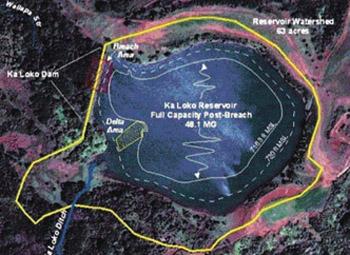LIHU‘E — The March 2006 Ka Loko Reservoir Dam disaster that claimed seven lives and wrought untold millions of dollars in property damage also had a considerable impact on the farming operations of the surrounding Kilauea area, a new report
LIHU‘E — The March 2006 Ka Loko Reservoir Dam disaster that claimed seven lives and wrought untold millions of dollars in property damage also had a considerable impact on the farming operations of the surrounding Kilauea area, a new report shows.
The final version of an engineering and monitoring study was presented to the Kaua‘i County Council last week. The report, which was prepared by O‘ahu-based Sustainable Resources Group International, Inc. at the behest of the county’s Office of Economic Development, said the breach reduced the reservoir’s capacity from 400 million gallons to 48 million gallons.
Andy Hood of SRGII said ongoing civil and criminal lawsuits muddle the future of the irrigation system in place in the North Shore community and complicated work on the study because the Kilauea Irrigation Company, a major player, declined to work with SRGII.
“The failure of the dam, corresponding loss of storage, and uncertainty over whether the structure will continue to be available for irrigation jeopardizes this water resource and those farmers who depend on it,” the report’s executive summary says.
The full report can be accessed at srgii.com/projects/KilaueaIrrigationWaterEngineering_Final_June09.pdf
While the county commissioned the study, ultimately, any decisions regarding the future of water in the Kilauea area will be made by the state Department of Land and Natural Resources Commission on Water Resource Management, Council Vice Chair Jay Furfaro said Wednesday.
State biologist Don Heacock told the council that he supports the water budget analysis and suggested the council send a letter to DLNR and federal agencies.
Heacock and Moloa‘a water activists Hope and Tim Kallai said water usage by various parties — including the Mary Lucas Trust — should be fully disclosed.
“This is community water, it’s a public use resource and it’s for everybody,” Hope Kallai said.



